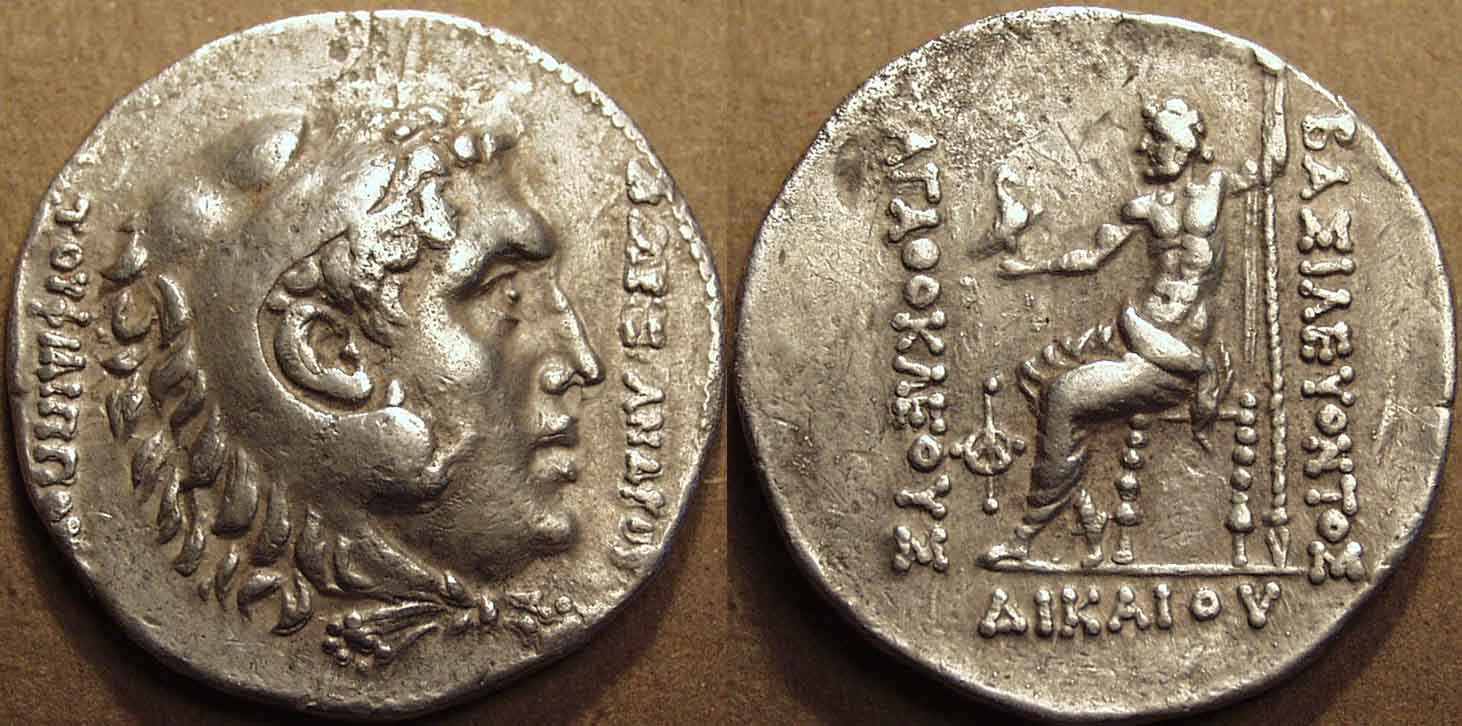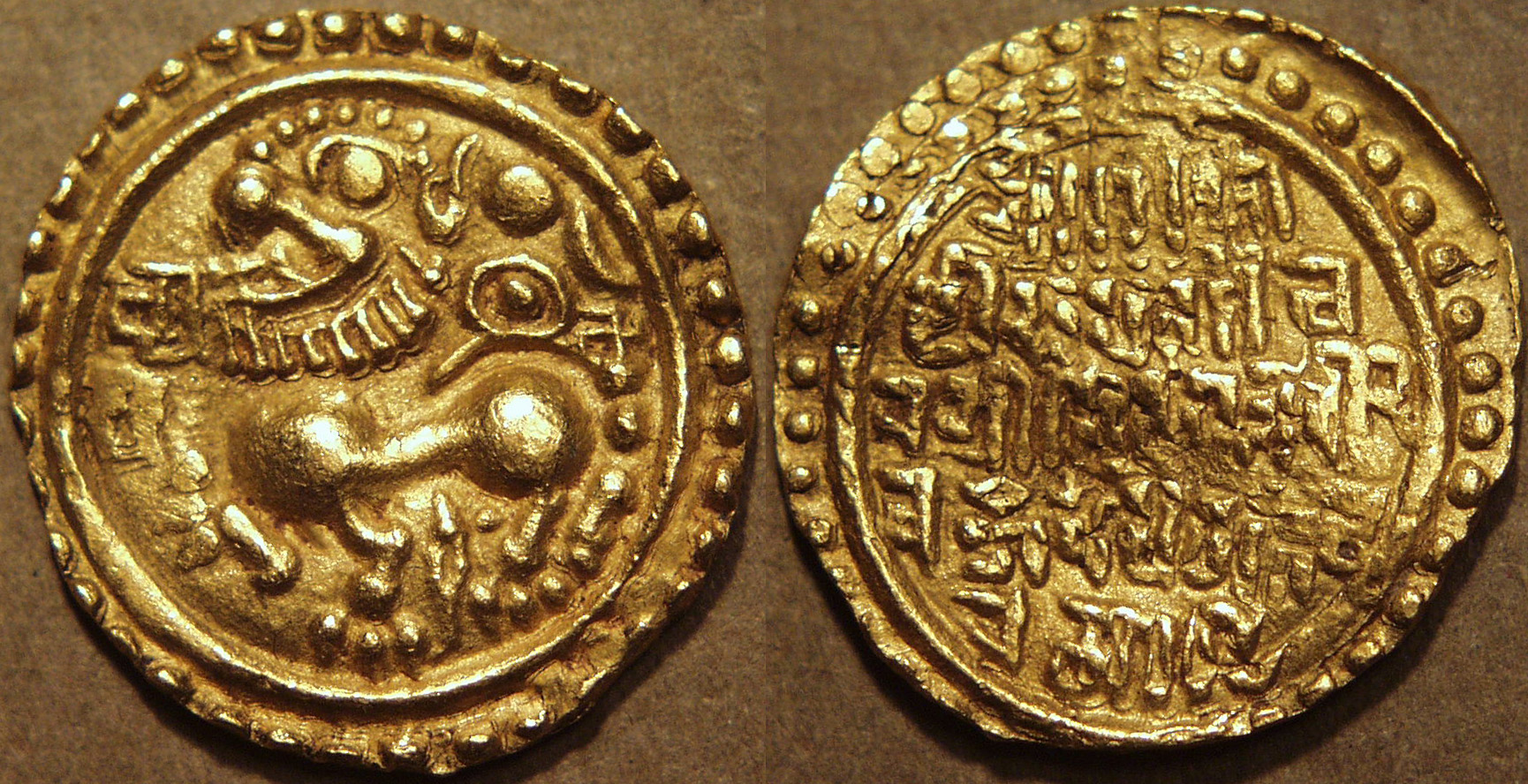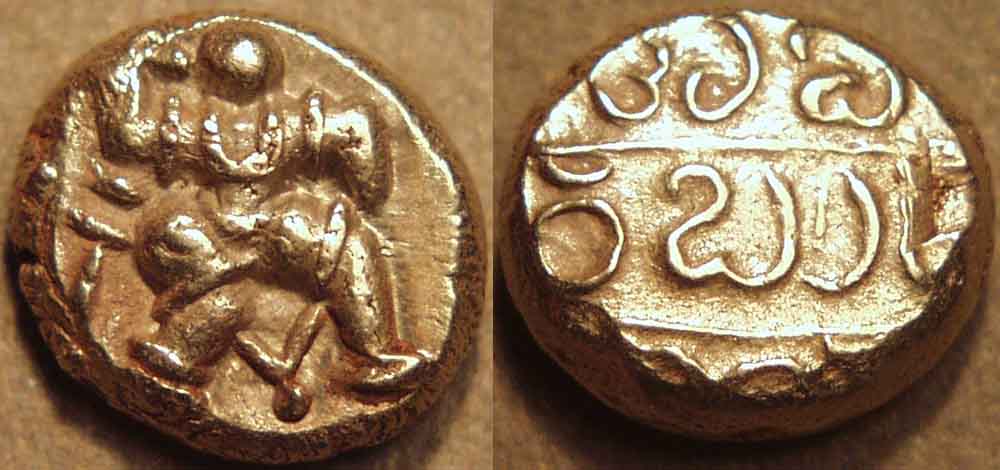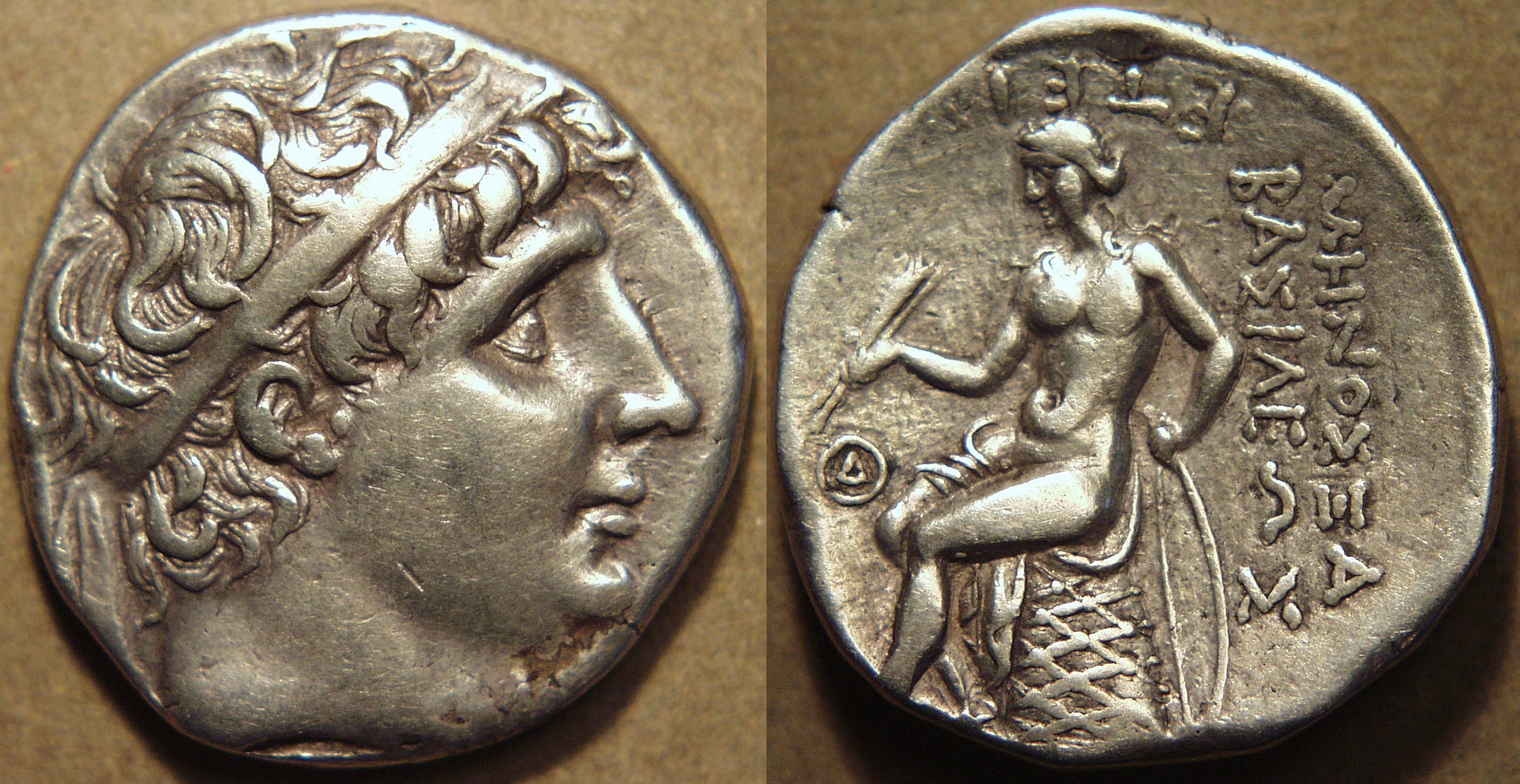
|
|
|

|
Bactria: Agathocles, Silver tetradrachm, c. 185-170 BCE
commemorating Alexander the Great
Weight: 16.49 gm., Diam: 31 mm., Die axis: 12 h
Head of Alexander facing right, wearing lion scalp, pearled border around
Greek legend: AΛEXANΔPOY TOY ΦIΛIΠΠOY /
Zeus enthroned left, holding sceptre behind him with his left hand
and holding eagle in his right hand,
Greek legend: BAΣIΛETONTOΣ ΔIKAIOY AΓAΘOKΛEOYΣ
monogram in lower left field |
|
The Indo-Greek king Agathocles ruled in Bactria and also south of the Hindu Kush mountains around 185 to 170 BCE. He produced some of the most interesting coins of the
Bactrian series, both because of their artsitry and their content. He was one of the first Greek kings (perhaps the very first) to issue coins in the "Indian" style: square in shape, to
an Indian weight standard and with legends in the local script, Kharoshthi. He also issued a remarkable series of coins known as the "Pedigree" series, in which he honors his
predecessors on the Bactrian throne, starting with this coin where he honors Alexander the Great himself! The coin follows the obverse and reverse images of the
coins of Alexander, but adds an Alexander legend on the obverse, while preserving the Agathocles legend on the reverse.
This coin was incredibly important in unlocking the mystery of the pedigree coins. Until its discovery, numismatists were having a hard time figuring out what these coins
signified, and most thought they meant that Agathocles had been co-ruler with all these different kings. But once the Alexander coin was discovered, it became apparent
that these coins were intended to establish Agathocles's pedigree. Why exactly Agathocles issued these coins is not known for certain, but we can speculate about it. The Bactrian
Kingdom was founded when the local Seleucid governor, Diodotus I, broke away from his Seleucid masters and declared himself independent. Around the time of Agathocles, it
appears that a scion of the Seleucid royal family, Eucratides, attempted to lay claim to the throne of Bactria, and indeed he did so successfully. Perhaps it was in this context that
Agathocles attempted to establish his own pedigree, since he faced a rival who claimed royal descent himself. Eucratides also issued some pedigree coins featuring his mother, who
belonged to the Seleucid royal house.
You can see more coins of Agathocles, including almost his entire pedigree series, on the Agathocles page, and more
coins of the Indo-Greeks, starting with the Seleucids and then using the "Next" button on each page to scroll
through the galleries in chronological order.
|

|
Guptas: "Chandragupta III" = Purugupta ? gold dinar, c. 451-55 ?
Weight: 8.28 gm, Diameter: 18 mm.
King standing left, holding an Indian long bow in his left hand and an arrow in his right
Garuda standard plus additional object (a crescent moon) at left,
Brāhmī legend under arm: Chandra, circular Brāhmī legend around /
Lakshmi seated facing on a stylized lotus in padmasana, holding lotus blossom and diadem,
Brāhmī legend at right: Sri Vikramah
|
|
The attribution of this coin is still uncertain. It appears to be an issue of a king who ruled after Kumaragupta I and either before or even
contemporaneously with Skandagupta.
At the moment, numismatists are calling this king Chandragupta III, since the name chandra appears under the king's arm. I have recently written a paper suggesting that
perhaps this "Chandragupta III" was none other than Purugupta.
Purugupta was the son of Kumaragupta with his principal queen, the mahadevi Anantadevi. Whether or not he ever ruled is not known with certainty, and, if
he did rule, it is not known when he did so. Some authors believe he succeeded his father but was deposed or otherwise succeded by his half-brother Skandagupta. Others argue
that he ruled briefly after Skandagupta.
It is also not known if Purugupta issued any coins, and, if he did, which ones they are. In my paper, I discuss these
issues and explore the possibility that these coins of "Chandragupta III" are in fact issues of Purugupta.
You can see more coins of "Chandragupta III" here.
|

|
British India, Bombay Presidency,
Silver rupee in the name of Shah Alam II (1759-1806), Bombay, 1832-35
Weight: 11.62 gm. Diameter: 28 mm Die axis: 7 o'clock
Legend, naming Shah Alam II and listing AH date 1215
Legend, including mint name Surat, mintmark 5-petalled flower with stem
and regnal year 46
Reference: Pridmore 286, KM 678a
|
|
This is one of India's first machine-made coins ... the first issue of the new Bombay mint, which commenced operations in 1832 and
continues to this date. The coin is full of fictions. Issued in the years 1832-35, it lists as the date AH 1215, which corresponds to the years 1800-01! It is issued in the name of
Shah Alam II, who had died in 1806, and lists his regnal year of 46, which corresponds to AH years 1217-18, thus conflicting with the listed AH date of 1215! Finally, it names as
its mint Surat, even though it was actually issued in Bombay! All of these fictions are so appropriate for a coin issued in the name of a puppet Mughal emperor by a powerful
colonial power, whose presence is formally indicated only by the 6-petalled flower at left on the reverse!
You can see more coins of British India here.
|

|
Kadambas of Goa: Sivachitta (c. 1147-81) Gold pagoda
Weight: 4.40 gm., Diam: 20 mm.
Lion left, cyclic date at left /
5-line Nagari legend: Sri Sapta ko / tisa Labdhava / ra Sri Sivachitta Vira /
vara deva Malava / ramari
|
|
The Kadambas were an ancient ruling family of Karnataka, who had founded the first indigenous Kannadiga kingdom in Banavasi in the
4th century. That kingdom lasted
for some 200 years, but eventually came under the Chalukyas of Badami, becoming their feudatories. It appears that the family may have remained in this position of vassalage
to the Chalukyas of Badami and then to the Rashtrakutas. Then, in the late 10th century, the Kadambas supported the Chalukyas of Kalyan in their struggle against the
Rashtrakutas. After the Rashtrakutas were defeated, it appears the Kalyani Chalukyas gave the Kadambas some measure of independence, one branch in Hangal and another
in Goa.
The Kadambas of Goa enjoyed this period of independence for over 250 years, during which they issued a handsome series of gold coins. They eventually succumbed to an
invasion from the Yadavas of Devagiri in the first half of the 13th century. Eventually this territory fell to Alauddin Khilji and, after a brief period as part of the Delhi Sultanate, was
absorbed into the Bahmani kingdom.
You can see more coins of the Kadambas of Goa here.
|

|
Bukka Raya I Gold pagoda or gadyana
Weight: 3.38 gm. Diameter: 11-12 mm Die axis: 5 o'clock
Warrior (King?) advancing right, right hand raised, sword at hip
Kannada legend: sri vi / ra buka / raya

Reference: MNI ---, MSI 392
|
|
The Vijayanagar Empire was founded in 1336 by two brothers, Harihara I and Bukka I, who probably had been generals in the Hoysala army. The Hindu kingdoms of South
India were being overrun by Muslim invaders from the north, and the brothers, inspired by the Hindu saint Vidyaranya, resolved to try to stem this tide. They did so spectacularly,
creating a Hindu empire that covered almost the whole of southern peninsular India for some 200 years.
This coin is a wonderful example of Bukka Raya's gold coinage. You can see more Vijayanagar coins here.
|

|
Punchmarked coin from Vidarbha
Silver 1/3 karshapana
c. 5th century BCE
Weight: 1.21 gm., Dim: 16 x 16 mm.
Ref: unpublished
|
|
Coins similar to this one used to be incorrectly attributed to the Andhra janapada because these coin types were known from a single hoard found
in Andhra. There have now been multiple finds of similar coins in Vidarbha, and so they have been reassigned to the Vidarbha janapada. See Prashant P. Kulkarni's paper
"Coins of Vidarbha Janapada" in the ONS Newsletter, 178, Winter 2004 for a fuller discussion and more details. Some authors believe that assigning coins to specific janapadas
is problematic and unproven, preferring to simply assign them to the area where they were found and await new information before deciding who issued them.
You can see more coins like this on the Vidarbha page.
|

|
Seleucid Empire, Antiochos I
Silver tetradrachm, c. 280 BCE
Weight: 16.94 gm., Diam:26 mm., Die axis:6h
Diademed, bust of Antiochos right/
Nude Apollo seated left on omphalos, leaning on bow with left hand,
holding arrow in right hand, Greek legend:
at right: MHNOΣ ΞA // BAΣIΛEΩΣ above: ETEI
Δ monogram of Ai-Khanoum in left field
Ref: Senior & Houghton ONS Newsletter 159 (1999), pp. 11-12
|
|
A remarkable and, so far, unique coin. It is the only early Seleucid coin to have a date (many later Seleucid coins did have
dates). It specifies the month Xandikos (March) and the year EI (15). We are not sure what this date signifies, but it is clear that this coin was issued to mark the change in
coinage from the horse-head reverse to the Apollo reverse at Ai-Khanoum, since it was clearly cut by the same celator who cut the first regular tetradrachms with the Apollo reverse.
What might this change of coinage have signified? If the year 15 represented the 15th year of Antiochos's reign, the date would be March 266 BCE. We know that in 267 BCE,
Antiochos had his son Seleucos put to death on suspicion of rebellion and subsequently appointed his younger son, Antiochos II, his viceroy in the East. This coin could then mark
the arrival of the new viceroy in Ai-Khanoum. (My thanks to Chris Bennett for help in understanding the coin.)
You can see more coins of Antiochos, including the horse-head reverse types and a regular Apollo-reverse tetradrachm cut by the same die-cutter who made this coin, on the
Antiochos page.
|

|
Awadh: Silver rupee in name of Shah Alam II, Banaras, AH 1189, RY 16
Weight: 11.09 gm. Diameter: 23 mm Die axis: 2 o'clock
Legend, mintmarks sun, star and sprigs, and AH year 1189 (= 1774-1775 CE) /
Legend, including mint name Muhammadabad Banares and regnal year 16
Reference: KM 36.3ff
|
|
This is one of the last coins issued before the East India Company acquired the mint at Banares from the Raja of Awadh in 1776, and
served as the prototype for the beautiful EIC coinage from that mint. This coin shows a sun mintmark
(in the form of six pellets) on the obverse and the curent regnal year only on
the reverse. The coins issued from this mint by the EIC replaced the sun with a fish mintmark and showed a double regnal year, the fixed RY 17 (the RY of the first British issues)
and then the progressive RY until the death of Shah Alam II in his RY 49. This coin was issued in AH 1189, the year in which the transition from Shuja ud Daulah to Asaf ud
Daulah as nawab took place, so it could have been issued in either one's reign.
You can see more coins of Awadh on the Awadh page.
|

|
Vijayanagar Empire, Krishna Devaraya (1509-29) Gold pagoda or gadyana
Weight: 3.32 gm. Diameter: 11 mm Die axis: 1 o'clock
Balakrishna seated facing, right leg tucked under and left leg hanging down,
flanked by chakra (discus) and sankh (conch)
Three-line Devanagari legend: sri pra / ta pa kri shna / ra ya
Reference: MNI 898, MSI 640
|
|
After the death of Deva Raya II in 1446, the Vijayanagar empire went into a period of decline as infighting within the ruling dynasty and challenges
from the feudal lords sapped the resources of the kingdom. Eventually, the general Tuluva Narasa seized power and restored order. Krishna Devaraya was Tuluva Narasa's son
and he raised the empire to its greatest height, expanding north at the expense of the Sultanates, east into Kalinga and south into the peninsula.
No coins were apparently made in Vijayanagar for around 50 years before Krishna Devaraya introduced the Balakrishna coinage. In all probability, this coinage commenced only
after 1513, when Krishna Devaraya defeated Prataparudra Gajapati, the king in Orissa. As part of his booty from this war, Krishna Devaraya brought back to Hampi a seated figure
of Balakrishna, and he built a large temple in Hampi to house this image. The statue now resides in the Government Museum, Chennai, and can be seen
here. It appears that the image on the coin is the mirror image of the Orissa
sculpture, probably because Krishna Devaraya's die-cutter did not allow for the fact that he was making a "negative" of the final image.
You can see more coins of Krishna Devaraya on the second Vijayangar page.
|

|
Gwalior (Princely State): Mahadji Rao (1761-1794) Silver rupee
in the name of Shah Alam II, year 21, AH 1194
Weight: 11.34 gm. Diameter: 22 mm Die axis: 10 o'clock
Legend, naming Shah Alam and the AH date 119x (probably 1194)
Legend, including regnal year 21, mintmark dagger and mint name Ujjain
Reference: KM 218 (C259)
|
|
The princely state of Gwalior arose in the early part of the 18th century as one of the constituent states of the Maratha confedaracy. The founder was Ranoji Shinde (later
anglicized to Scindia), a local chieftain who distinguished himself as a soldier and received a grant to serve as the governor in his area. He and his successors expanded the state to
a position of great strength and influence. This was relatively short-lived, however, as by 1802 the British had established control over central India and Gwalior was forced to give up
considerable parts of its territory. Nevertheless, the state still remained relatively large and was one of the only five so-called "21-gun" states at the time of Indian independence.
Gwalior was also one of only 9 Princely States that continued to issue its own coinage right up to the time of independence; most others eventually adopted the coinage ofBritish
India.
Mahadji Rao was the illegitimate son of Ranoji. This coin is a most interesting one, because it shows the full mintmark, which is hardly ever seen. The mark is normally
described as a scimitar, but here we see that it is almost certainly meant to be a dagger, with a wavy blade like a kris. So this coin suggests that a reassessment is necessary of
what exactly the Ujjain mintmark is.
You can see more coins of Gwalior state on the Gwalior page. |
|
|